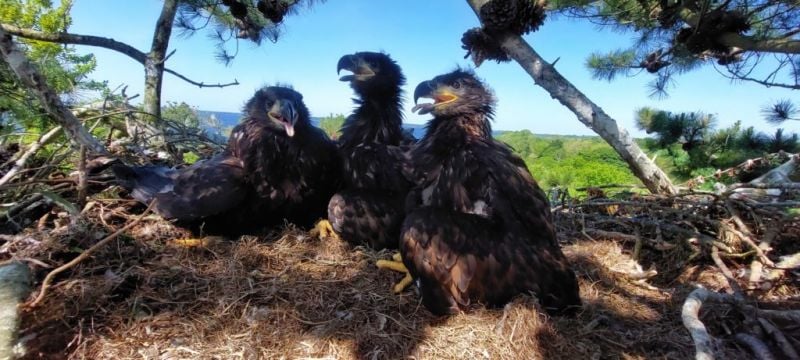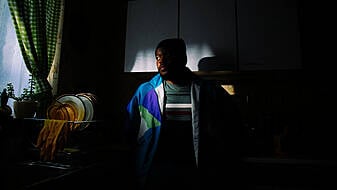The National Parks and Wildlife Service (NPWS) is celebrating the hatching of five new white-tailed eagle chicks in Co Clare.
The NPWS said the newly-hatched chicks come from the bonding of eagles released under the white-tailed eagle reintroduction project, which aims to bring the species back to Ireland.
Of particular note, a previously “widowed” male eagle that had been without a partner for four years has recently bonded with another female that was released in 2020.
The male eagle was originally released in Killarney National Park in 2008 and set up territory with a female from that batch, eventually making a nest in the Lough Derg area.
In 2013, this pair nested successfully and fledged a pair of chicks – the first hatching and fledging of a white-tailed eagle in more than 110 years in Ireland.
The same pair successfully fledged further chicks for the next four years until 2018, when the female of the pair died after contracting avian flu.
The male eagle then lived alone in East Clare for the past four years until he recently paired up with his new partner and welcomed two new chicks, the NPWS said.
The female chick comes from a batch of 16 white-tailed eagle chicks collected from the wild nests in Norway and sent to Ireland for the release programme in 2020.
The chick was released a site in Lough Derg but flew back to Scotland after her release.
It returned to Ireland six months later and bonded with the widowed male.
They then set up a territory together, building a nest in February of this year on an island in Lough Derg.
Eamonn Meskell, who leads the NPWS white-tailed eagle reintroduction project, said: “We have been monitoring these eagles for many years and of course we feel very familiar with their history as part of the project.
“The male eagle has been single for four years since his previous partner died. Of course, the fact that he has now found and bred with a new partner is significant to our project but we’re also delighted to see this eagle that we know well make a new bond and start a new family.
“A story like this really brings our reintroduction programme to life, as it helps people to learn about eagle breeding behaviour and the fragility of our reintroduction efforts, all told through the story of a widowed eagle.
“For our project, the appearance of any new chick is a milestone and shows that the continuation of the project is proving successful.”
At a separate site in Co Clare, three other chicks reared by one of the offspring of the male eagle and its previous partner were observed and tagged by the NPWS in recent days.
The NPWS said this female offspring has reared 10 chicks which are spread around the island of Ireland, some of whom themselves are forming pairs.
Mr Meskill added: “It is also incredible that one of his offspring is now herself rearing three chicks.
“This is a very rare occurrence, as a very small minority of nest sites – in Ireland, Norway or anywhere else – have more than two chicks on nest.
“This is the second year that three chicks are on the nest at this particular nest site. This shows how suited Ireland and our lakes are from a habitat and feeding perspective for this reintroduction project.”
Minister of State for Heritage Malcolm Noonan the successful hatching “symbolises the patience and careful planning” of the reintroduction project.
“It gives us great hope and encouragement for the project which we always knew would take time and perseverance.”
He added: “The news from Clare today of five chicks born to eagles from both phases of the reintroduction programme – and indeed to their offspring – shows why our continued efforts, perseverance and hope can lead not just to lovely stories such as this, but to hope and good news for nature.”
The original reintroduction programme between 2007 and 2011 involved releasing 100 young white-tailed eagles in Killarney National Park, County Kerry which subsequently dispersed widely throughout Ireland.
By July 2020, a small breeding population of eight to ten pairs had successfully fledged 31 chicks across counties Cork, Kerry, Clare, Galway and Tipperary.
Some Irish-bred eagles are now reaching maturity and starting to breed in the wild.
However, a scientific review of the reintroduction project indicated the small population is still vulnerable to mortality factors such as Avian Influenza, illegal poisoning and extreme weather events.







